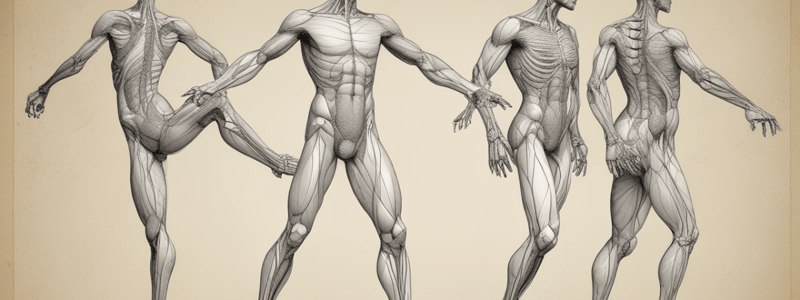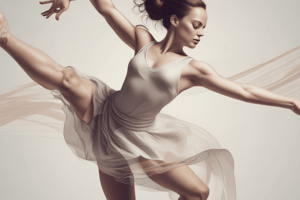Podcast
Questions and Answers
What is the primary function of the spine in dance?
What is the primary function of the spine in dance?
- To provide flexibility to the upper body
- To act as a bridge between the upper and lower body
- To facilitate movement in the lower limbs
- To provide support and stability to the upper body (correct)
What is the main role of the pelvis in dance?
What is the main role of the pelvis in dance?
- To act as a bridge between the spine and legs (correct)
- To provide support to the core muscles
- To provide balance and stability to the upper body
- To facilitate movement in the lower limbs
What is the primary function of the bones in the lower limbs in dance?
What is the primary function of the bones in the lower limbs in dance?
- To provide foundation for dance movements (correct)
- To facilitate movement in the lower limbs
- To act as a bridge between the spine and legs
- To provide stability to the upper body
What type of muscles are primarily used in dance?
What type of muscles are primarily used in dance?
What is the role of the quadriceps and hamstrings in dance?
What is the role of the quadriceps and hamstrings in dance?
What is the role of the glutes in dance?
What is the role of the glutes in dance?
What is the role of the abdominal and back muscles in dance?
What is the role of the abdominal and back muscles in dance?
What is the role of the calf and ankle muscles in dance?
What is the role of the calf and ankle muscles in dance?
What is the role of the shoulder and arm muscles in dance?
What is the role of the shoulder and arm muscles in dance?
What is the role of the prime mover muscle in dance?
What is the role of the prime mover muscle in dance?
What is crucial for dancers to execute movements efficiently with proper technique and alignment?
What is crucial for dancers to execute movements efficiently with proper technique and alignment?
What is the primary function of the respiratory system in dance?
What is the primary function of the respiratory system in dance?
Which anatomical structure is responsible for providing support for the spine and improving balance?
Which anatomical structure is responsible for providing support for the spine and improving balance?
What type of exercises can improve a dancer's muscular strength, endurance, and flexibility?
What type of exercises can improve a dancer's muscular strength, endurance, and flexibility?
What is the importance of deep diaphragmatic breathing in dance?
What is the importance of deep diaphragmatic breathing in dance?
What is the primary goal of analyzing the connection between anatomy and injury prevention in dancers?
What is the primary goal of analyzing the connection between anatomy and injury prevention in dancers?
What does the kinetic chain refer to in dance?
What does the kinetic chain refer to in dance?
What is the significance of the pelvis and hips in dance?
What is the significance of the pelvis and hips in dance?
What is a crucial component of injury prevention in dancers?
What is a crucial component of injury prevention in dancers?
Why are the feet and ankles crucial for dance technique and injury prevention?
Why are the feet and ankles crucial for dance technique and injury prevention?
What can proper warm-up routines, cool-down exercises, and stretching help prevent in dancers?
What can proper warm-up routines, cool-down exercises, and stretching help prevent in dancers?
What is the importance of understanding the bony structure and joint articulation of the pelvis and hips in dance?
What is the importance of understanding the bony structure and joint articulation of the pelvis and hips in dance?
What can help dancers optimize their performance and enhance their technique?
What can help dancers optimize their performance and enhance their technique?
What is the primary benefit of strengthening core muscles in dance?
What is the primary benefit of strengthening core muscles in dance?
What is the role of the core in dance technique and stability?
What is the role of the core in dance technique and stability?
What can lead to muscle imbalances in dancers?
What can lead to muscle imbalances in dancers?
What is essential for dancers to maintain overall physical health?
What is essential for dancers to maintain overall physical health?
What can help dancers identify potential imbalances and prevent injuries?
What can help dancers identify potential imbalances and prevent injuries?
What is the main function of the spine in the human body?
What is the main function of the spine in the human body?
Why is it important for dancers to understand the anatomy of the shoulder girdle and upper extremities?
Why is it important for dancers to understand the anatomy of the shoulder girdle and upper extremities?
What is the primary function of the muscles of the lower body in dance?
What is the primary function of the muscles of the lower body in dance?
What is the benefit of incorporating anatomical knowledge into dance training and practice?
What is the benefit of incorporating anatomical knowledge into dance training and practice?
What is the main component of the skeletal system that provides strength and protection?
What is the main component of the skeletal system that provides strength and protection?
What is the process called where old bone is broken down and new bone is formed?
What is the process called where old bone is broken down and new bone is formed?
What type of joints are most relevant to dance?
What type of joints are most relevant to dance?
What is the role of the skeletal system in movement?
What is the role of the skeletal system in movement?
How many bones are in the human skeletal system?
How many bones are in the human skeletal system?
What is the purpose of the bone marrow in the skeletal system?
What is the purpose of the bone marrow in the skeletal system?
What is the primary benefit of understanding anatomy in injury prevention?
What is the primary benefit of understanding anatomy in injury prevention?
What type of exercises can help support and protect vulnerable areas?
What type of exercises can help support and protect vulnerable areas?
What is an important component of a warm-up and cool-down routine?
What is an important component of a warm-up and cool-down routine?
Who can provide personalized assessments and guidance for injury prevention?
Who can provide personalized assessments and guidance for injury prevention?
What is the result of analyzing the connections between anatomy and injury prevention?
What is the result of analyzing the connections between anatomy and injury prevention?
Why is understanding anatomy essential for dancers?
Why is understanding anatomy essential for dancers?
Flashcards are hidden until you start studying
Study Notes
Exploring Key Anatomical Structures in Dance
- The respiratory system supplies oxygen to the body and is essential for efficient breathing and stamina in dance.
- Deep diaphragmatic breathing engages the core muscles and improves stability.
- The core, consisting of abdominal muscles, lower back muscles, and glutes, provides support for the spine, improves balance, and enhances movement execution.
- Strengthening core muscles optimizes dance performance and helps prevent back injuries.
- The pelvis and hips form the foundation of movement and control, and understanding their bony structure and joint articulation enhances range of motion and proper alignment.
The Skeletal System and Its Role in Movement
- The skeletal system provides the framework for the body, supporting and protecting vital organs and allowing for movement.
- The skeletal system consists of 206 bones, categorized into axial and appendicular bones.
- Bones undergo remodeling, a process where old bone is broken down and new bone is formed, essential for maintaining bone health and strength.
- Joints, where two or more bones meet, allow for various ranges of motion, and synovial joints, such as the knee and hip joints, are most relevant to dance.
The Muscular System in Relation to Dance
- The muscular system plays a vital role in creating movement, facilitating strength and flexibility, and supporting the overall physicality of dancers.
- There are three main types of muscles: skeletal, smooth, and cardiac, with skeletal muscles being responsible for voluntary movement.
- Key muscle groups used in dance include the quadriceps and hamstrings, glutes, abdominals and back muscles, calves and ankles, and shoulder and arm muscles.
- Muscles work in pairs or groups to create movement, and understanding their functions and interactions is crucial for efficient movement execution.
Analyzing the Connection between Anatomy and Injury Prevention
- Biomechanics, the study of how forces interact with living systems, is essential for injury prevention in dance.
- Analyzing the kinetic chain, the interconnectedness of the skeletal and muscular systems, helps identify how movement in one area affects other regions.
- Muscle imbalances, common in dance, can lead to injuries, and understanding anatomy helps identify potential imbalances.
- Common dance injuries include sprains, strains, tendonitis, stress fractures, and muscle tears, and understanding anatomy helps identify contributing factors.
- Injury prevention strategies include proper warm-up and cool-down routines, strengthening exercises, and seeking professional guidance.
Studying That Suits You
Use AI to generate personalized quizzes and flashcards to suit your learning preferences.




